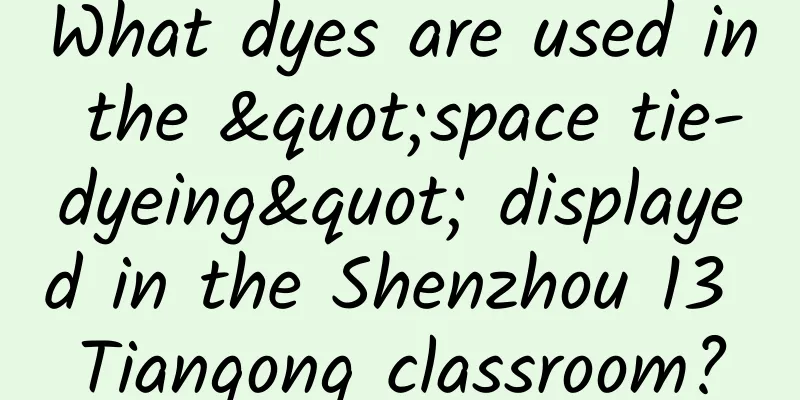What dyes are used in the "space tie-dyeing" displayed in the Shenzhou 13 Tiangong classroom?

|
On the afternoon of March 23, 2022, the Shenzhou 13 astronaut crew cooperated with each other to complete the second lesson of the Tiangong classroom. During the class, astronaut Wang Yaping demonstrated and explained my country's traditional and unique folk handicraft - tie-dyeing. Tie-dyeing has a long history and was already very mature in the Eastern Jin Dynasty. Tie-dyeing products were widely used in women's clothing during the Southern and Northern Dynasties, and tie-dyeing textiles were very popular during the Tang and Song Dynasties. In 2006, the tie-dyeing technique was approved by the State Council and selected as a national intangible cultural heritage. What dyes are used in tie-dyeing? Tie-dyeing with plant dyes has a long history in my country. Plant dyeing, also known as "plant dyeing", refers to a method of dyeing the dyed object by extracting pigments from various pigment-containing plants that grow naturally in nature. Plant dyes are usually obtained from pigments extracted from the roots, stems, leaves, flowers, fruits and juices of plants. They can be used to dye natural fibers and natural regenerated fiber textiles. This not only avoids the serious pollution caused by chemical dyes, but also conforms to modern people's natural, simple and environmentally friendly lifestyle. In the Book of Songs, the earliest collection of Chinese poetry, “Qingqing Zi Jin” and “Lü Yi Huang Shang”, Xunzi's "Encouragement to Study" says "The disciple surpasses the master". It describes the extraction and application of plant dyes. Because natural dyes contain different types of pigments, they can display a variety of colors. Although plant dyes have been passed down in my country for thousands of years, and the Qing Dynasty document "Xuehuan Embroidery Book" records more than 700 colors, in daily use, the plant dyes usually used are as follows: Blue dyes - indigo, woad, etc. Red dyes: madder, safflower, etc. Yellow dyes - Sophora japonica, turmeric, etc. Purple dyes - comfrey, perilla, etc. In addition, there are brown dyes (Dioscorea), black dyes (Gallanum chinense, Sumac), etc. Vegetable dyes are not only used for dyeing textiles, but are also commonly used for dyeing woven baskets. (Editor: Liu Dan) |
>>: Battle and coexistence between humans and viruses | Science Gallery
Recommend
How to operate an event well? 7 things to pay attention to
For a novice operator , how can you do a good job...
Alipay launches new anti-fraud function: identifies transaction fraud risk and notifies the guardian
[[258298]] In the era of mobile payment, the role...
Which is more expensive, fur or mink? The difference between the two
Fur and mink are two types of fur fabrics that we...
What should we do when the activities are ineffective in attracting new users and it is difficult to operate seed users?
1. The new user acquisition activities for C-end ...
Mars' leopard print may be the most powerful evidence of life
NASA 's Perseverance rover has discovered pos...
Weekly Star News | The longest partial lunar eclipse in nearly 600 years
/ The longest partial lunar eclipse in nearly 600...
Universal template for beginners of new media: I don’t know what content to create for my official account and it always goes off track. What can I do?
What I said here is basically applicable to all p...
What would you see if you really "fell" into the Great Rift Valley of East Africa?
The Great Rift Valley of East Africa is the large...
The current status and prospects of unmanned systems application on the battlefield
At the beginning of the 21st century, the deploym...
Can I apply for a mortgage payment deferral due to the epidemic? How to apply?
Recently, epidemics have occurred in many places i...
How to create a perfect hit event?
Being able to organize a perfect hit event is def...
The third wave of artificial intelligence has arrived. Changhong Q5N builds the core hub of smart home
"If intelligence is not fully realized and h...
3 new strategies for short video account positioning
One writer once said: "Go deeper into the ar...
How to design marketing language in live broadcast room?
The marketing language in the live broadcast room...
China Passenger Car Association & CAM: Passenger car market product competitiveness index is 91.0 in September 2021
The Automobile Market Research Branch of the Chin...









